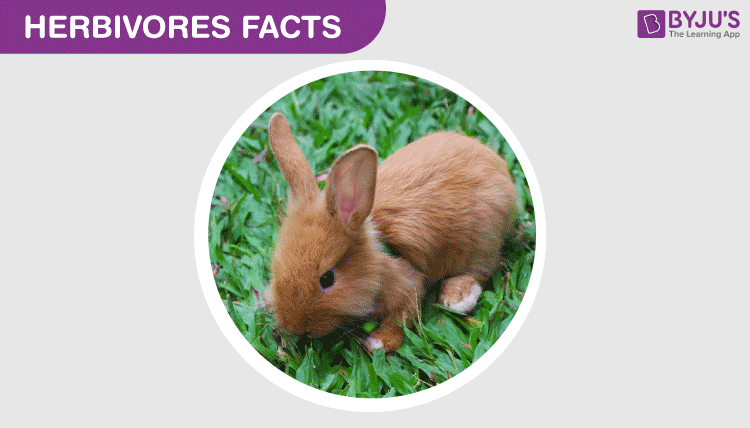Table of Contents
- Facts about Herbivorous Animals
- Types of Herbivorous Animals
- Herbivorous Animals and the Food Chain
- Protection against Predators
- Digestion in Herbivorous Animals
Herbivorous animals are the primary consumers that feed on plants. Cows, giraffes, kangaroos, and zebras are a few herbivorous animals that feed on grass, vegetables, fruits, and plants.
Let us have a detailed look at the herbivorous animals and some interesting facts about them.

Facts about Herbivorous Animals
Herbivores are animals that feed on plants and fruits. The largest herbivore on earth is the African elephant. Rabbits, cows, deer and zebras are a few examples of herbivorous animals.
Herbivorous animals have wide, blunt teeth that help them to pull the plants from the ground. They possess the ability to regurgitate their food. This helps them to absorb most of the nutrients from the food. Butterflies and hummingbirds have mouth shaped like straw to suck nectar.
Types of Herbivorous Animals
Herbivorous animals are of different types. Few of them feed on a variety of plants while some feed on a specific type of plant. Listed below are the types of herbivorous animals along with examples.
- The ones that feed only on fruits are called frugivores. Flying foxes and fruit bats are some frugivores.
- The animals that feed on leaves are called folivores. E.g. Panda, caterpillars, giraffes, koalas
- Herbivorous animals that feed on woods are called xylophages. E.g. Termites
- Nectivores are herbivores that feed on nectar. E.g. Butterflies
- The seed-eating herbivorous animals are called granivores. E.g. Pigeons
Herbivorous Animals and the Food Chain
The herbivorous animals transport photosynthetic energy in the tropics system. They are known as primary consumers. But not all the energy present in the plants will be transferred to the herbivores. Only 10% of the energy is transferred to the primary consumers. That is why the number of herbivorous animals is less than the number of plants on earth. Similarly, the number of carnivorous animals is less than herbivores on earth.
Protection against Predators
Herbivorous animals has several adaptations to protect themselves from enemies. Some adaptations include:
- Turtles have hard shells that protect them against predators.
- A millipede curls itself in the shape of a ball and releases a noxious substance that causes irritation in the eyes and skin.
- A few herbivores change their colour to match the surroundings to protect themselves from predators.
Also Read: Carnivores and Herbivores
Digestion in Herbivorous Animals
Herbivorous animals have broad and flat teeth that help to grind the cell wall of tough, fibrous plants. They do not contain the enzymes responsible for the breakdown of cellulose. They, therefore, digest the plants in either of the two ways:
- Foregut fermentation
- Hindgut fermentation
Foregut Fermentation: In this, the bacteria process the food and break it down before it is digested in the animal’s stomach. Such animals have several chambers in the stomach. This separates the bacteria from the acid-secreting part of the stomach and prolongs digestion so that it gets ample time for processing. These herbivorous animals are known as ruminants. Cows, kangaroos, etc. fall under this category.
Hindgut Fermentation: This process takes place in the latter part of the gut where the food is processed and broken down after digestion. Horses, elephants and zebras use hindgut fermentation.
Also Read: Difference between herbivores and carnivores
To know more about herbivorous animals and some interesting facts about them, keep visiting BYJU’S website or download BYJU’S app for further reference.
Frequently Asked Questions
What are herbivorous animals?
Herbivorous animals are the animals that feed on plants and fruits. Cows, buffaloes, goats, deer are some of the herbivorous animals. Herbivorous animals that feed on fruits are called frugivores, that feed on leaves are folivores while that feed on nectar are called nectivores.
What are the important characteristic features of herbivorous animals that help them to feed on plants?
The herbivorous animals have wide and flat molars that help in grinding food. The incisors in herbivores help them to tear plants. These might be present on either the upper or the lower jaws of herbivores. They have a longer digestive tract that is beneficial for the proper digestion of cellulose present in plants.
What features of herbivores help in the digestion of food?
The herbivorous animals have several chambers in the stomach. The cellulose present in plants is difficult to digest. The long digestive system of herbivores gives ample time to the microorganisms to digest cellulose.
Why are herbivores called the primary consumers?
Primary producers form the base of the food chain and are the organisms that prepare their own food and do not feed on any organism for their food. Primary consumers are the organisms that feed on the primary producers for their nutrition. Since herbivorous animals feed on primary producers, i.e., plants for their food, they are known as primary consumers. They are the primary link between the producers and consumers and pass the energy between them.
What are the different categories of herbivores?
Herbivores can be divided into the following categories:
- Frugivores that feed on fruits. Eg., bats
- Folivores that feed on leaves. Eg., cows, goats
- Grainivores that feed on seeds. Eg., pigeons
- Nectivores that feed on nectar. Eg., Butterflies
Further Reading:

Comments